Rotorway Exec Helicopter A Legacy To B.J. Schramm
RotorWay’s sleek helicopter is easier to build, swifter in flight and looks as good as a factory-built ship
ARTICLE DATE: November-December 1984
Rotorway Exec, the build-and-fly-it-your-self helicopter manufacturer in Chandler, Arizona, is one of those places where progress and improvement are constant; get out of touch for a few months and the company has a new program, an improvement on its product or a changed marketing plan.
However, change is never made merely for the sake of change; the new product or plan has to be demonstrably better than what it replaces. The two big items currently at RotorWay are its Exec-model helicopter and its expanded training program that culminates in a Private Pilot—Helicopter rating.
It now is possible to build your own helicopter and get a rating to fly it, all for the same price. RotorWay still offers its Scorpion 133 helicopter at a lower price than the new Exec, and either may be used in the build-and-learn program.
The Exec is a slick, all-enclosed, two-seat helicopter with excellent performance for its weight and power. A bubble-like enclosure gives it the appearance of a larger, turbine-powered, factory-built ship. And, its design, fit and finish carry out that theme; its a professional-looking machine.
Its generically related to the Scorpion, but it is a totally new helicopter. We first saw the Exec at the HAI (Helicopter Association International) convention and product show, where it looked right at home among the Bell JetRangers, Hughes 500s and Sikorsky.
The Exec drew lots of lookers at the fle rotor-flyers convention, but not many buyers; most of these people already had ratings and were flying the bigger ships commercially. Later that year, at the EAA convention at Oshkosh, the fans lined up 10-deep around the Exec display and packed all of President B.J. Schramm’s lectures on the subject.
A lot of newer ideas went into the design of the Exec, as well as at least one complete revision. According to Schramm, the first prototype of the new design didn’t fly well at all. and no matter what they did, it didn’t improve much.
So, it was back to the drawing board for the whole fiberglass fuselage design, and the second time around it came out right; it flew fast and straight, and was easier to handle than the Scorpion.
Like the Scorpion helicopter, the Exec has a welded, steel-tube framework that extends from the skids up to the rotor mount. It also extends from the front of the cockpit aft to the engine mount, but from there on it differs….the Scorpion has a welded-up tailboom where the Exec helicopter has a monocoque aluminum tube.
Both utilize a fiberglass shell over the frame to form a cockpit cover, but the Execs is far more extensive and streamlined. It completely covers the engine and an extra “doghouse” section atop the fuselage covers much of the drivetrain, as well.
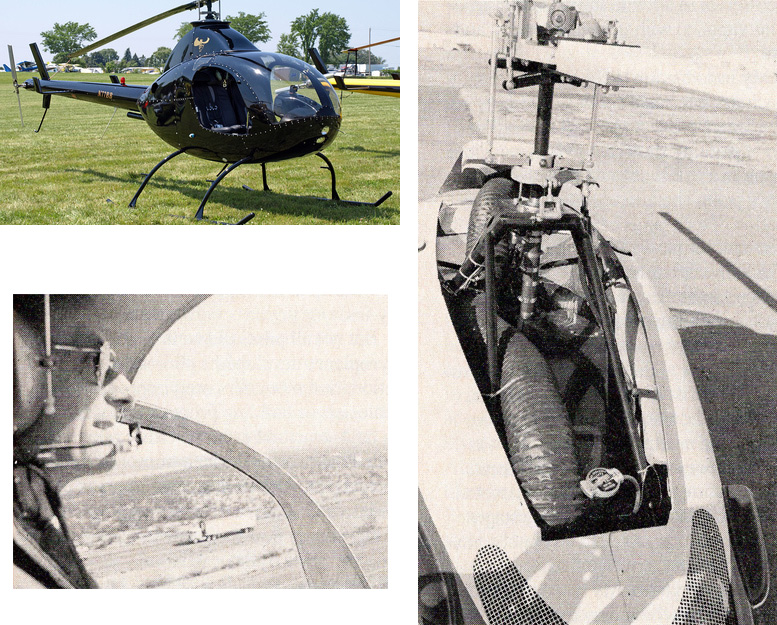
BOTTOM LEFT: Freeway flying at 250 feet and 75 mph . . . B.J. Schramm shows the Exec’s surveillance mode and a terrific view.
RIGHT: Cyclic links attach to the rotor hub rather than to the individual blade pitch horns, thus eliminating need for a vertically – movable swash plate.
Thus the Rotorway Exec is much sleeker and aerodynamically slicker than its predecessor. When Schramm designed the pop-riveted tailboom, he also redesigned the tail rotor drive-adjustment system.
Where the Scorpion requires individual tensioning of the tail rotor drivebelts (there are three), working from the engine out, the Execs drive system can be tensioned all at once by adjusting two bolts exposed when the small tailcone is removed.
New fuel tanks are rotationally-molded, cross-linked polyurethane plastic, and strong enough to resist 15G impacts. They also are form fitted to get maximum capacity in a cramped space, each tank holding 7.5 gallons. Schramm likes to demonstrate the tanks’ toughness by beating on them with a claw hammer.
An ultra-simple cyclic control system was developed for the Rotorway Exec and it eliminates bellcranks and control rods by using dual push-pull cables. This makes rigging much easier and provides a dual load path for safety.
The RotorWay design uses cyclic inputs to control the swash plate, which in turn controls the angle of the rotor head relative to the attitude of the helicopter. This eliminates some expensive and sophisticated designs used on other helicopters, though it shortens the e.g. range of the ship.
RotorWay uses the ships battery as movable ballast; it’s located in the tailboom when two people are aboard, but must be relocated to a compartment in the nose when the pilot. The Exec’s rotor shaft is driven by multiple rubber belts from a reduction “bull wheel;” the engine drives the belt wheel through a duplex chain.
While it may be a little less sophisticated than a current production helicopter, it nonetheless eliminates expensive transmissions, gears, shafts, etc., which would be too cosdy for the homebuilder. The Rotorway Exec system is reliable and durable, and includes a belt-tensioning device to act as a rotor-engagement clutch.
Like other parts of the Exec, the engine is unique to RotorWay. In fact, it is RotorWay’s own design and construction and is the only liquid-cooled aircraft engine in the air today (excepting the V12 Allison and Merlin engines in restored warbirds).
This four-cylinder, opposed engine follows the same basic layout as a Volkswagen automobile engine, from which it originally sprang, but it has been completely redesigned and is now produced in RotorWays own foundries.
It operates in a vertical position (crankshaft parallel to the rotor shaft) and has a dry-sump lubrication system. A husky 145-cubic-inch engine, it produced 145 horsepower at 4500 rpm, burning approximately 8.5 gallons per hour.
What’s more, complete with dual radiators and water pump, it weighs about the same as an 0-320 Lycoming of equal output. The engines are cast, machined, assembled and dynomometer-tested in RotorWay’s extensive facilities, prior to being shipped to its helicopter customers.
A similar engine, lowered to 100 hp and redesigned to operate horizontally, was marketed briefly to fixed-wing aircraft builders, but met with considerable resistance; despite comparable prices, the builders opted for less-efficient, aircooled engines.
The engine is quieter than most, probably because of excellent muffling (and a tuned-length, scavenging exhaust header system) and the water jackets. In fact, the whole Exec is quieter than any other small helicopter we’ve heard.
At 450 rpm, the rotor blades do not seem to be creating that thrashing noise usually associated with helicopters, and at full speed, the tail rotor also is unobtrusive: it’s one of the few “good neighbor” helicopters.
The rotor blades are a new design as well, being asymmetrical in airfoil shape where the previous blades were symmetrical. These new blades are bonded as well as riveted and arrive at the builder’s shop almost ready to install.
He must fit in some wooden filler blocks before they are completed and mounted on the rotor hub. The new rotors give the Exec an improved rate of climb as well as slower descent during autorotations …about the equivalent of adding 15 hp to the Rotorway Exec engine’s output, the RotorWay president declared.
Schramm offered a training session in the demonstrator Exec, and we leaped at the chance. But, without comparable experience in other helicopters, we cannot draw comparisons.
RotorWay students usually begin with hours of hovering practice to learn basic control coordination, but we did ours in the air. After about an hour, we got so we could hold it more-or-less straight and level, and could make a turn or two.
Back at the hover pads, we chased the ship all around the area before we nearly got it under consistent control, but by then our learning process has been slowed to a standstill by the fatigue of concentration.
In short, we can say that it seemed easy enough to learn the Rotorway Exec control, with proper instruction and enough practice. And it proved to be enjoyable enough that we’d like to pursue a helicopter rating sometime.
A RotorWay Exec would seem to provide the ideal program for the person who wants to bake his cake and eat it, too. We had trouble at first finding what Schramm calls the “pressure point,” where you can hold the Exec in perfect balance between lift, gravity, thrust and drag.
This takes just the slightest pressure and seems almost more to be sensed than felt. Movements of the cyclic control also must be sensed rather than consciously moved, and it takes a while before a pilot develops a properly conditioned response.
“Because we fly the hub rather than the blade on the Rotorway Exec, it takes less control power fore and aft than laterally. You don’t have to move the stick as far laterally as you do fore and aft to get the same response, and that’s why you can’t catch it at first, until you learn the right ‘mix’ of forces on the cyclic,” Schramm explained. “Once you get the feel of it, you can fly the ship successfully.”
If a pilot already has a helicopter rating, then the RotorWay instructors go over the stick force differentials before they fly; if a pilot is new to helicopters, then the instructors let the pilot “feel” his way to the correct pressures before they explain it all.
“It allows us to completely separate the cyclic and collective controls in the teaching process,” Schramm commented. “Our hub design lets us do that without much penalty, and we’ve been able to make a safer system for the amateur-built helicopter”.
“Once you’ve learned to hold an attitude, the turns become an easy thing to do. It’s just a matter of learning to hold what position you like for the climbing or descending turn, and positioning the stick for that attitude and leaving it alone. We do it with a constant manifold pressure setting, 25.5-26 inches if we want to climb, 24 inches if we want to descend.”
“You have to be able to feel the pendulum swing . . . the attitude change . . . and then return to the pressure point before you can maintain straight-and-level flight,” Schramm explained.
Normally, the student learns his attitude control at hover height, where ground references provide strong visual cues, and once he’s mastered that, he graduates into climbout and cruise modes. Hover training takes the first one-week session at RotorWay’s Sky Center, climbout and cruise another week-long training visit.
If the pilot wants to gain an FAA helicopter rating (which he must have if he expects to carry a passenger with him on any flights), then he must return to the Sky Center for a third week of training that prepares him for the rating checkflight.
Stretch Wolters, RotorWay’s chief flight instructor, is the FAA-designated examiner. The five-day learning weeks at RotorWay are utilized for much more than teaching the Exec or Scorpion builder how to fly a helicopter.
Most of the time spent there is taken up in classroom sessions where audio-visual presentations and hands-on instruction teach him the correct way to rig, tune and maintain his own ship. He also learns helicopter theory and flight fundamentals.
When the builder is finished with the first week’s session, he’s ready to return to his home base and practice hovering. Later, he goes back to Chandler for a second session, where he picks up more flight, more theory and more maintenance training.
RotorWay’s component package shipping is keyed to the training program, too. The builder receives his ship in “groups” that give him the correct construction sequence.
They are:
Rotorway Exec Group I
Special tool kit, tailboom, airframe, landing gear, fiberglass body and windshield windscreen, seats, floorpan and doors—the outer shell of the helicopter.
Rotorway Exec Group II
Engine mount, cyclic control, collective and directional controls, tail rotor and drive.
Rotorway Exec Group III
Lower collective, secondary drive, oil bath.
Rotorway Exec Group IV
Fuel system, rotor tachometer, clutch torque, oil cooling system, water pump, radiator, fan shroud, fan drive, standpipe and hoses, instrument panel and wiring harness, engine instruments.
Rotorway Exec Group V
Rotor hub, rotor blades, swash plate. Group VI -RW-145 engine, battery.
Current list price for all the groups is $25,874, though each group may be purchased separately. And, there are crating charges and optional equipment, plus freight, so a builder could figure on nearly $27,000 for his project.
Comparing an Exec with a new or used lightweight factory-built helicopter, plus training, shows a good deal higher outlay. A well-thrashed Bell 47 goes for $30,000 + , and it probably will have high-time components needing imminent, expensive replacement.
And, you’ll need a licensed A&P to do the work (an Exec or Scorpion builder can do his own maintenance). Flight training easily can add another $3000-$4000 to the cost, too. New light helicopters start at the $83,100 list price for a Robinson R22: a Hughes 300 or Enstrom Shark tops $135,000 retail.
Thus the RotorWay program offers good value to the pilot ready and capable of doing his own construction. In return he gets a good-looking, good-performing helicopter with which he can have lots of fun, a helicopter rating, and that great, priceless pleasure of flying something he’s built with his own hands.
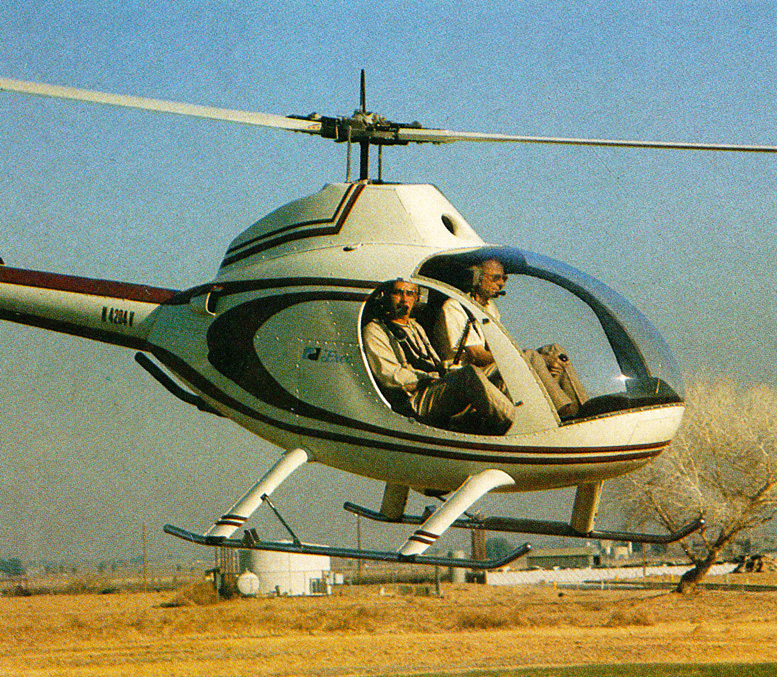
| Rotorway Exec 145 Kit Helicopter Specifications | |
|---|---|
| Rotor diameter | 25 ft. |
| Length overall | 21.5 ft. |
| Height overall | 7.83 ft. |
| Landing skid track | 5.08 ft. |
| Cabin width | 3.67 ft. |
| Tail rotor diameter | 4.167 ft. |
| Gross weight | 1285 lb. |
| Empty weight | 830 lb. |
| Useful load, equipped | 4401b. |
| Payload. full fuel | 350 lb. |
| Fuel capacity, std | 15 gal. |
| Auxiliary fuel | 5 gal. |
| Seats | 2, sbs |
| Engine | RotorWay RW-145, four cylinders opposed, water-cooled, 145 hp at 4500 rpm. |
| Maximum speed, sea level | 105 mph |
| Normal cruise. 2 persons | 90mph |
| Range at optimum cruise | 153 s.m. |
| Range at max. fuel, 1 person | 228 s.m. |
| Rate of climb | 1200 fpm |
| Service ceiling | 9500 ft. |
| Hover in ground effect | 6500 ft. |
| Hover out of ground effect | 4000 ft. |
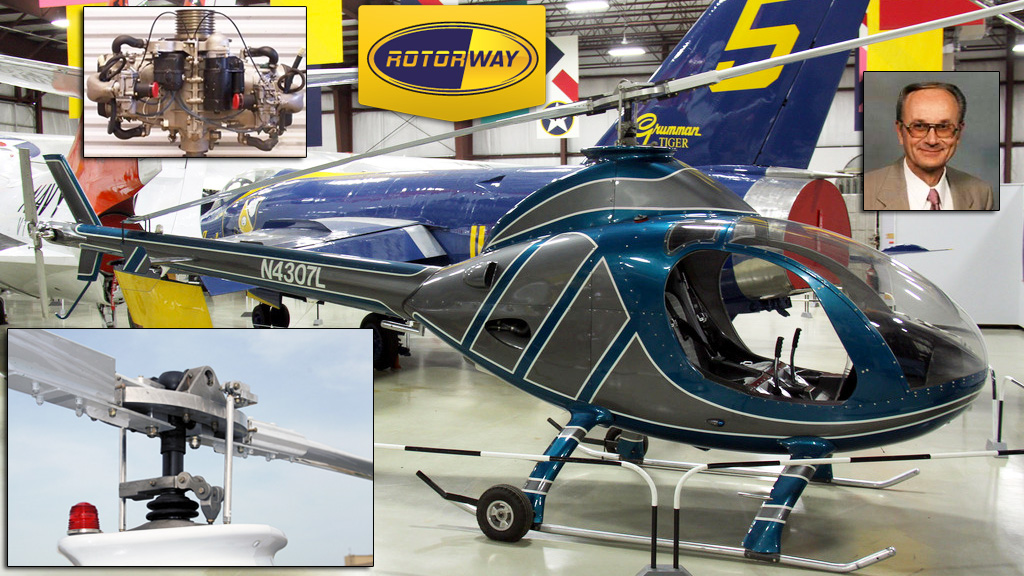

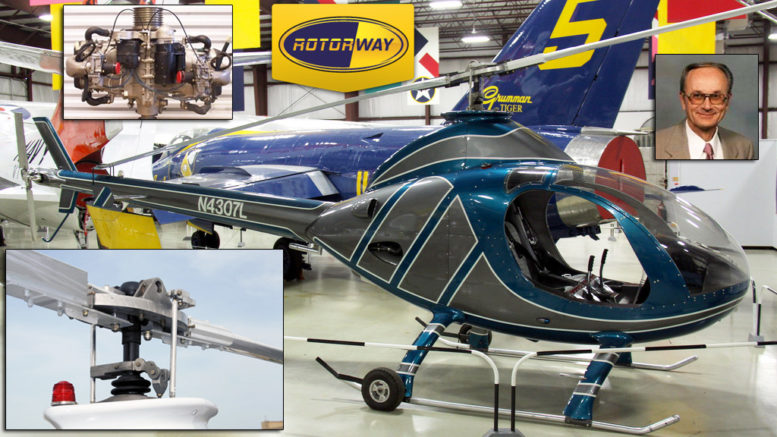
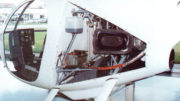
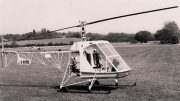
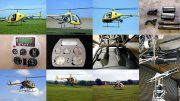
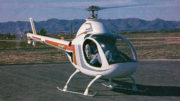
Be the first to comment on "Flying The Rotorway Exec RW145"